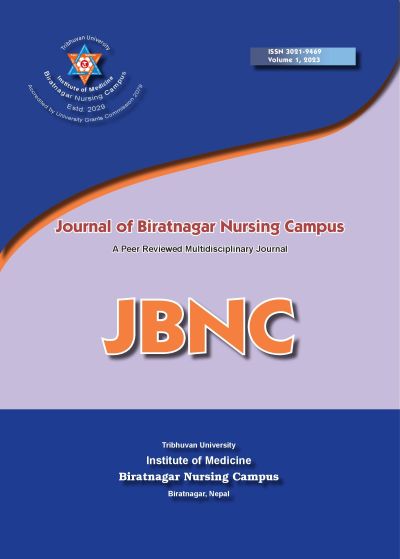Infant and Young Child Feeding Practices among Mothers Attending a Government Hospital
DOI:
https://doi.org/10.3126/jbnc.v1i1.63264Keywords:
Infant and Young Child, Feeding Practice, MothersAbstract
Background: Appropriate young children (from birth to two years of life) feeding practice is very crucial to boost up children’s survival and optimum growth and development. Early initiation of breastfeeding (within an hour of childbirth), exclusive breastfeeding for six months and providing nutritionally adequate and appropriate complementary feeding for six months and continued breastfeeding up to two years of age or beyond are the major components of infant and young child feeding (IYCF) practices. The objective of the study was to find out the IYCF practices of mothers.
Methods: Descriptive cross-sectional research was used and all 180 mothers attending government hospital of Biratnagar were the sample. Interview-based data collection was used by a self-developed, structured and semi-structured questionnaire. Data were analyzed using descriptive statistics using SPSS version 25.0.
Result: Less than half (40%) mothers started breastfeeding within an hour after delivery, 90.6% fed colostrum, 73.3% practiced exclusive breast feeding and 89.4% continued to feed breastmilk along with complementary feed to under two years children. Among mothers, 68.3% started feeding complementary food at appropriate age, 70.6% of the mothers fed minimum numbers of time or more according to their child age, 80% mothers used to provide diverse food and 66.1% children were receiving minimum acceptable diet.
Conclusion: The prevalence of timely initiation of complementary feeding at 6 months, minimum dietary diversity, minimum feeding frequency and minimum acceptable diet were satisfactory as almost two third and more children have met minimum acceptable diet. However, practice of early initiation of breast feeding is still low.
Downloads
Downloads
Published
How to Cite
Issue
Section
License
Copyright (c) 2023 Biratnagar Nursing Campus

This work is licensed under a Creative Commons Attribution 4.0 International License.
This license enables reusers to distribute, remix, adapt, and build upon the material in any medium or format, so long as attribution is given to the creator. The license allows for commercial use. If you remix, adapt, or build upon the material, you must license the modified material under identical terms.




